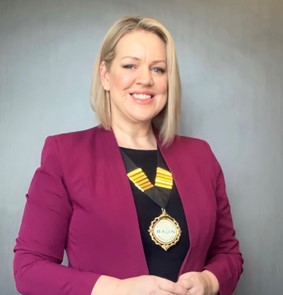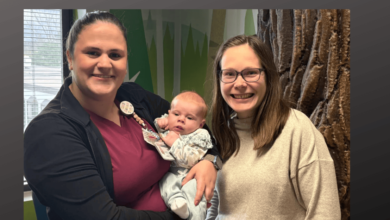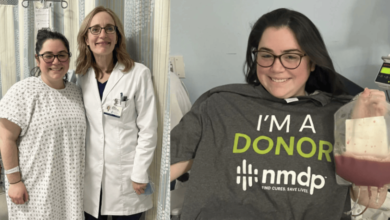A history of urological nursing in the UK

Introduction
If you have been involved with our association for any time you will be aware of the fact that BAUN is as much about being part of our community as it is about anything else. Rachel Leaver (previous BAUN trustee, newsletter editor and general friend of BAUN) passed away suddenly in 2021. Before she died, Rachel put together a history of urological nursing, excerpts of which we have pleasure in presenting to you now.
Rachel was a founder member of BAUN and she and the other Councilors worked hard to carve out our niche in the world of professional associations. Similarly, urological nursing wasn’t always recognised as a defined clinical specialty in its own right often seen as a branch of general surgery or medical nursing. Through the efforts of those earlier colleagues however, we now have our own professional identity and all the education and networking benefits that it attracts.
In sharing Rachel’s writing with you, we honour her commitment to BAUN, her colleagues and friends. At our last BAUN conference in Edinburgh (2022), we had great pleasure in launching our commemorative award to further honour her memory. Please look out for this and our other award categories to enter for this year’s Gala Awards event in Liverpool.

Sarah Hillery, BAUN president
Rachel Leaver, former nurse lecturer and founder member of the British Association of Urological Nurses, reviews the history of urological nursing.
It is difficult to pinpoint exactly when nurses moved from being general nurses to identifying themselves as urological nurses.
Nurses, like surgeons, would have looked after people with urological problems on general wards and so it is fair to assume that as the surgeons branched out into the specialty the nurses that worked in those specialist hospitals became specialised too.
Nursing history
Before the 1880s most people were nursed at home rather than in hospitals. Consequently any nursing tended to be done by family members or servants.
Caring for a person’s intimate needs was not considered seemly for well brought up females especially if not a member of the family and basic needs such as hygiene and feeding were seen as the domestic duties of servants.
Certainly nursing was not seen as needing many skills, knowledge or abilities and those employed as such very often were able to do little else.
Florence Nightingale herself described them as being “ too old, too weak, too drunken, too dirty, too stupid or too bad to do anything else” (Thomas, 2016).
This all changed as more people began to receive hospital treatment as technology became more sophisticated.
More educated woman began their nurse training at the newly opened schools of nursing and by the late 19th century the way nurses were perceived changed and they were regarded as having the higher levels of nursing skills needed on these hospital wards.
Florence Nightingale herself was the founder and patron of the Nightingale Training School at St Thomas’ Hospital in London in 1860 following on from her leading a team of nurses caring for solders in the Crimean War and of course Mary Seacole’s role in setting up a convalescent home for soldiers in the same war.
Another nurse, Ethel Bedford Fenwick, had a big role to play in shaping how nursing progressed though she is not as well known or often mentioned in the literature.

Ethel Bedford Fenwick
Ethel was born in 1857 and was a surgeon’s daughter. He died when she was a child and she was brought up in Nottinghamshire by her mother and her step father who was a wealthy member of parliament.
Though she did not need to work she decided she wanted to be a nurse and became a special probationer (eg someone of a middle class background who paid a fee in exchange for her training) at age 21, ultimately becoming matron at St Bartholomew’s hospital in London at the age of 24.
She retired from nursing at age 30 after the birth of her son after her marriage to Edward Bedford Fenwick who was a surgeon (incidentally his brother was the eminent urologist Edwin Hurry Fenwick).
However, she did not give up on nursing or her quest to tackle the varying standards of training and bring all nursing under one profession (NMC, 2019).
Edith firmly believed that nurse training should be of at least three years duration (not the one or two years that was customary at the time) and that only those nurses who had completed this training could call themselves “nurse”.
She was committed to the professionalisation of nursing, firmly believing nurses had their own set of professional standards and attributes and should not be seen as just doctor’s handmaidens.
She was also adamant that nurses should be registered disagreeing with Florence Nightingale who did not think this necessary.
She founded the British Nurses’ Association and lobbied parliament tirelessly for over 30 years to establish a nurses’ register.
Ultimately, the Nurses Registration Act of 1919 established the first professional register. Ethel Bedford Fenwick’s name is listed as state registered nurse number 1 and 2019 marked the hundredth anniversary of the UK nursing register.
Over the years, nurses distinguished themselves during the first and second world wars where they could rise to officer status as part of the Queen Alexandra Imperial Military Nursing Service (QAIMNS). Male nurses were finally allowed to join the profession in 1951.
The United Kingdom Central Council took over the role of registering qualified nurses in 1972 and this role was in turn taken over by the Nursing and Midwifery Council in 2002 (Ford, 2017; Griffen, 1995).
Nurse training evolved over the years and eventually by 1986 nurse training moved out of the traditional hospital based schools of nursing and into colleges and universities.
Instead of the apprenticeship model of learning nurses now emerged with diploma level nurse training and by 2004 it was decided that all nurses should have degree only preparation.
By 2009 all nursing courses in the UK became degree level courses. The profession is now seen as representing a highly skilled sector of workers which has its own specialised body of knowledge.
Nurses are trained in institutions that are under the regulation of the profession itself and only nurses on the register are employed as qualified nurses to look after patients.
Only a member of the profession is competent to assess another professional’s work as it is the profession that defines what nursing is and how it is organised and developed.
And all nurses are governed by a code of ethics to ensure the safety of patients and ensure they are not exploited. This code also regulates how the profession interacts with other professions.
As time has moved on the opportunities for nurses to expand their skills and abilities and consequently their practice has grown exponentially.
Nurses now undertake extended roles often taking on junior doctors’ roles to provide nurse led services from diagnosis to treatment and aftercare and since 2002 are able to train as non-medical prescribers.
Urological nurses have embraced their potential and over the years identified areas where they could put their knowledge and skills to good use in setting up services for patients.
Urological nurses nowadays run anything from pre-operative assessment clinics to minor surgical interventions and anything in between.
History of urological nursing
The first hospital for Stone and Diseases of the Urinary Organs, which was founded in in 1860 at 42 Great Marylebone Street, can arguably be pinpointed as the time the first urological nurses came into being.
By the 1900s when the first suprapubic prostatectomy was performed by Mr Peter Freyer, the hospital had established itself as having the reputation of successful removal of bladder stones by litholapaxy but also moved its emphasis to surgery for prostatic obstruction.
Any nurses working there at the time were, therefore, the first stone and prostate care nurses.
By the time the hospital moved to new premises in Henrietta Street and amalgamated with the three other hospitals around Covent Garden (to become known as the 3Ps which confusingly included the Shaftesbury Hospital, the former French Hospital in Shaftsbury Avenue), their importance as centres of excellence and innovation meant doctors and nurses who wanted to extend their knowledge and expertise moved there to work and train.
The English National Board (ENB) course in renal and urological nursing ran there until the change in nurse education moved into universities rather than being run in schools of nursing directly attached to a hospital.
Post-registration courses such as the ENB ones followed suit and the courses are still run today with nurses gaining degrees and masters in urological care.
The original course is still linked to the urology department at University College London Hospitals (UCLH) where the 3Ps were ultimately relocated on closure of the Covent Garden hospitals with a joint appointment of a urology nurse as lecturer practitioner between the hospital and university.
Over the years more university modules and short courses in urological care have become available in the UK and Northern Ireland.
However, as with all post-registration education in recent years, funding is limited and these courses are few and far between.
The education of urological nurses is one of the key reasons the British Association of Urological Nurses (BAUN) was inaugurated and continues to be the main aim of the association 25 years on.
Interestingly in 2015 the urology department moved yet again from the main UCLH tower building on the Euston Road to Westmoreland Street in Marylebone.
This is just round the corner from 34 New Cavendish Street, which now marks the spot of the original house (42, Great Marylebone Street before the streets were renamed) bought as the first hospital for bladder stones and other urological diseases in 1860. So back to where it all started!
Box 1: Urology nursing lecture notes of Myrtle Wilson
Myrtle Wilson trained as a nurse from 1931-34 at the European General Hospital, Mumbai.
Decades later, the European General was renamed St George’s Hospital and is where Mumbai’s first dedicated urology department was opened in the 1960s.
Images below: Myrtle Wilson’s meticulous nursing notes reproduced here show what nurses were taught about cystitis, renal stones and acute nephritis in the 1930s.



Myrtle Wilson was born into a British military family in India 1913. Her dreams of becoming a nurse were realised when she won a place to train at the prestigious European General Hospital in Mumbai where the nurse uniforms were supplied by Harrods!
Importantly the EG nurse training was recognised by the UK General Nursing Council which meant that in the future she could seek work in the UK.
After completing her basic nurse training, nurse Wilson undertook further study including courses in midwifery and tropical disease medicine.
For a year she worked as a private nurse to wealthy families and often received gifts for her hard work, the most unusual of which was a tiger cub!
Her career went from strength to strength and she soon became a ward and theatre sister before achieving the position of Matron at the Ramsay Hospital in the Himalayan resort town of Nainital.

Myrtle Wilson on the left

Myrtle Wilson bottom left
In 1938 she travelled from India to England where she settled with her sister in Hull.
She nursed privately until the outbreak of WW2 when she joined the Queen Alexander Nursing Corps as a theatre sister and was stationed in Northern Ireland.

Sister Myrtle Wilson far left
It is there that sister Wilson met her future husband James Johnston, a Scot who worked in the dental corps.
They married in 1941 and 1943 they moved back to his native Dundee with their first child.
In 1949 and now a mother of two, she was unable to undertake a full time position at the Dundee Royal Infirmary (DRI) in the new National Health Service, but she did manage a part time post in the Casualty’s fracture clinic.
During her time at DRI she was unfortunately exposed to and subsequently developed pulmonary TB which resulted in a protracted admission to Ashludie Sanatorium.
Following recovery, Myrtle Wilson retired after an illustrious and varied career which spanned both continents and healthcare systems.
Written by Fiona Holden, urology nurse practitioner and Myrtle Johnston’s granddaughter
History of the British Association of Urological Nurses (BAUN)
In 1992, Sarah Heatley, a urology research nurse started BURNS – the British Urology Research Nurse Support Group.
This spurred other urology nurses to contact nurses working in urology up and down the country to establish if there was a need for a similar organisation supporting urology nurses in general.
A call went out and, at a memorable meeting at the Royal College of Surgeons in London in 1995, the room was crowded with nurses working in urology who were not only interested in the concept but were passionate that there was a real need for an organisation to support them and BAUN was born.
Of course were it not for the hard work of a self-less few nurses who put themselves forward to form the first committee/council BAUN would not be where it is today.
As a member of BAUN since its inception on that day in 1995, the author has vivid memories of the first study days they organised and ran for the new membership.
These usually ran in parallel with BAUS conference days as many nurses habitually attended that conference so it was felt that they would be able to attend sessions at both events.
For a while the Wednesday in conference week was dubbed “nurses’ day” and this had a separate programme which included joint sessions between BAUS and BAUN members.
There were some very brave nurses who stood up to speak and run the gauntlet of a barrage of questions and criticisms from the medics in the audience.
However nurse’s day did mean 300-400 nurses descending on the conference venue on masse and there were some BAUS members who objected to the presentations and exhibitions being overrun by such big numbers.
The author remembers walking into an afternoon session only to realise that the lunch time closed BAUS meeting was not quite over yet and to hear one consultant (who shall remain nameless) complain about this and propose that nurses be banned from future conferences!
Happily the BAUS president at the time did not agree to this however soon after the nurses’ programme was moved from the Wednesday to the Monday – in other words the day before BAUS conference started.
Naturally many nurses were not happy with this as it meant having to stay on to attend BAUS presentations and the exhibition which made the whole thing too costly for many.
Also, the exhibition was not up and running on the Monday so those who only came for that day could not benefit from seeing the new products and speaking to the representatives.
Company sponsorship for nurses to attend conferences was not easily available at the time with many companies preferring to sponsor doctors or specialist nurses working in stoma care or continence.
Consequently, BAUN made the decision to breakaway from this format and started to hold its own independent study days up and down the country, eventually launching its own annual three-day conference. Over the last 25 years the association has continued to grow and flourish.
Most of this is down to the commitment and hard work of urological nurses from all sub specialities taking on the role of council members (now trustees) and the vision and leadership of the 10 presidents who took on the post since its inception (Box 6).
From the first president to the current incumbent each has broadened the remit and scope of the association as urological nurses’ career pathways evolved and expanded.
With 800 plus members and several projects on at any one time the association now also depends on a professional management company for its day to day management and most importantly for the organisation and running of the annual conference.
BAUN now has charity status and is committed to its remit of providing educational services for its members and urological nurses in the UK (Box 5).
It provides study days which are free to members to attend and the annual conference remains the highlight of the urology nurse’s calendar.
BAUN has long established collaborative relationships with the European Association of Urological Nurses (EAUN) and the Australian and New Zealand Urological Nurses Society (ANZUNS) thus not only sharing ideas and practice but also working on joint projects which will ultimately impact on urology nurses worldwide.
The relationship with BAUS continues with amongst other things collaborations on practice guidelines such as cystoscopy training for nurses.
The association continues to evolve and understands the importance of communicating with its members via the quarterly newsletter, the BAUN website and more recently through social media.
Members use these forums for keeping up to date with the latest news about BAUN but also for sharing innovative practice, exchanging views and advice on setting up services, practice issues or difficult cases.
One of the biggest milestones for the association was the launch of the International Journal of Urological Nursing (IJUN) in a bid to encourage urological nurses to publish their work.
This is an area in which urology nurses need encouragement and nurturing to engage with the process and share their knowledge and expertise and was the incentive to invest in such a big project.
The journal is now in its 12th year and publishes work from urology nurses all over the world. It remains the only international peer-reviewed journal of its kind.
Box 2: Reflections of Julia Taylor, BAUN president 2016-18
It was as a BAUN trustee and education lead (under the leadership of Jerome Marley BAUN president 2005-06) the association commissioned the first research project ‘A baseline description of the research, clinical practice and development needs of urology nurses in the United Kingdom’.
This specifically highlighted a plethora of different titles used by urology nurses and the lack of nationally recognized education programmes, leading to recognition of nursing practice at an advanced level.
As I was elected as BAUN President nearly 10 years later, the lack of a nationally recognised educational framework
continues to impact the development and delivery of clinical practice today.
As part of a strategic approach to developing further progress BAUN commenced members’ engagement exercises on key questions about the development of an educational framework.
This uniquely came at a time when the first comprehensive review of the urological NHS services the ‘Urology Getting it Right first time’ GIRFT project was in progress.
Contributing to the GIRFT report offered an excellent opportunity to highlight again the unmet needs of urological nursing within a political context, whilst exploring changes that are required to address areas of need in research, clinical practice and development.
It importantly highlighted the significant role that urological nurses play in the delivery of high quality, patient focused urological care. The report, consistent with BAUN strategic aims, gave further momentum to the action that was clearly needed.
Subsequently, international colleagues from the European and Australian and New Zealand Urological nursing associations and societies are collaborating in the Educational framework for Urological nurses (EFUN) project.
I look forward to seeing the outcome of the project with the development of national guidance that will continue to build on the huge commitment of many professional, experienced, passionate and enthusiastic nurses dedicated to the development of urological services over the last 25 years.
I hope that this will serve to inspire a new generation of nurses with a clear career structure for those that want to take on the varied and exciting roles from foundation to advanced practice in urological nursing in the years to come. This clearly is vital to provide safe, high quality Urological services for our patients.

Julia Taylor
Box 3: Jane Champion – urology ward sister and matron
Changes in urological nursing at St Peter’s (the 3Ps) over the years
The good, collaborative working relationships between nursing and medical teams – acknowledging experience and expertise on all sides – was the climate that fostered development, change and modernisation and encompassed three seismic moves over 20 (ish) years.
For example, the move from Covent Garden to the Middlesex hospital, then to University College London Hospitals (UCLH), and most recently to Westmoreland Street in Marylebone.
Nurses were quick to see benefits of innovations in organisation/care management and were ready to implement them; eg evidence-based practice, individualised care and care plans, named nurse, team nursing etc.
Certainly all were happy to dispense with nursing rituals as perpetuated elsewhere where no evidence found; e.g. pre-op shaving, routine bowel prep for all, consultants’ whims and having traditional formal ward rounds.
Nurses were encouraged to innovate and create new nursing roles to facilitate and improve continuity/quality of care; these included clinical nurse specialists for continence, stoma care, continent urinary diversions, research and cancer.
The new role of clinical practitioners as part of clinical firms was also launched with practitioners working with the andrology, stones, reconstruction, bladder cancer, cancer and benign prostate, and reconstruction and female urology teams.
The department also has a lecturer practitioner in post who is seconded to London South Bank University to provide degree and masters level study to ensure excellence in successive generations of urology nurses.
The many changes and innovations over the years challenged nurses to widen their skills and knowledge.
Innovations included implementation of pre-assessment processes which enabled the shift to shorter length of stay/day surgery plus developments in surgical and anaesthetic techniques which widened the range of patients who could be treated safely e.g. spinal injuries patients with renal stones, elderly patients with co-morbidities.
As endoscopic and percutaneous surgery revolutionised various treatments, the need for involved practical nursing care diminished and evolved more into psychological preparation and provision of patent information; masses of written info was produced!
Lithotripsy started as a terrifying total immersion into a bath under G.A. for delivery of powerful shock waves to kidney stones (necessitating a day trip to St Thomas’s Hospital in the very early days) and evolved into an out-patient appointment in our own dedicated department over the course of a few years!
One of the greatest achievements was the publication of “Urological Nursing” which was the first of its kind. A ground-breaking urological nursing text book written and edited by nurses, all working in the same specialist unit which went on to be an international best-seller.
The first issue was published to mark the move from the Covent Garden to the Middlesex Hospital in 1992.
Box 4: Reflections on becoming a nurse cystoscopist
Vanessa Basketter – lead urology nurse, University Hospital Southampton NHS Foundation Trust is an NHS Foundation Trust (pictured below)
With the reduction in junior doctors’ hours an alternative had to be found for some regular investigations. At this time there were only a handful of us nurses scoping.
This was about 1994. We had to learn with the “eyeball” scopes – we did not have video then! After completing my training I took on the training of registrars through each rotation and this continues today. Gradually the number of nurse cystoscopists expanded as qualified nurses took on the training of fellow nurses.
There was little in the way of guidelines when I started and there wasn’t a limit to the maximum amount of patients to be seen on one list. We would scope from 8am until 6pm with 30 minutes for lunch and see a patient every 5-10 minutes!
It is much more structured now and strict disinfection guidelines have helped regulate lists. Nurses have developed skills to include biopsy, diathermy and Botox injections.
When it came to prostate biopsies – everyone (mostly registrars) used to “have a go” but not on a regular basis. Some very suspect biopsy samples were taken by a “see one do one” finger guided approach!
It was when bone and urethra came back in a sample that it was decided that best practice would be to train nurses to become expert at this skill.
This was in about 1999-2000. Again there were no national guidelines at the time. I trained with a consultant radiologist twice a week.
Back then we only took 2×3 samples with no local anaesthetic. It took a while to get to grips with the ultrasound and I remember the day when he said to me “thank God you’ve finally got it”!
From that point taking prostate biopsies became the sole domain of the specially trained urology nurses. Again these nurses also took on the training of other nurses as well as doctors to undertake this procedure.
At one point we were the training point for biopsies in our region. We adapted and introduced the use of local anaesthetic and we fought for upgraded equipment and ultrasound.
We also developed PGDs for the drugs we used. We worked with BAUS and BAUN to develop the formal guidelines which remain in use today.

Vanessa Basketter

Members of BAUN at their 2022 annual conference
Box 5: About the British Association of Urological Nurses
The British Association of Urological Nurses is a registered charity which aims to promote and maintain the highest standards in the practice and development of urological nursing and urological patient care.
The charity’s objects are specifically restricted to the promotion of the advancement of education in urological nursing and urological patient care for the benefit of the community as a whole, and in particular the provision of training courses, endorsement schemes, education materials, meetings and conferences
Who is the Association for?
The Association provides information to professionals working in urological nursing and provides a mutual network of support to urological nurse specialists and others working in urology. Membership of BAUN offers opportunities to participate in the development of the profession and to help improve patient care.
Aims of BAUN
- To help to improve the care of urological patients in all healthcare settings
- To organise conferences and study days to help educate urological nurses
- To provide educational materials including guidelines, websites, newsletters for BAUN members
- To provide personal development opportunities for BAUN Members through involvement in running the association
- To influence the urological healthcare agenda
- To work collaboratively with other organisations to the benefit of patients
Box 6: BAUN alumni (council officers)
President
- Sarah Heatley (1995-1997)
- Mary Kirkham (1997-2002)
- Lyn Kirkwood (2002-2004)
- Jerome Marley (2004-2006)
- Tom Ladds (2006-2008)
- Lucinda Poulton (2008-2012)
- Phillippa Aslet (2012-2014)
- Fiona Sexton (2014-2016)
- Julia Taylor (2016-2018)
- Jane Brocksom (2018-)
Honorary secretary
- Mary Kirkham (1995-1997)
- Louisa Fleure (Ashford) (1997-2001)
- Jane Gosling (2001-2004)
- Vanessa Basketeer (2004-2006)
- Julia Taylor (2006-2007)
- Hilary Baker (2007-2012)
- Tracey Rowe (2012-2014)
- Jane Brocksom (2014-2017)
- Emma Chappel (2017-)
Honorary treasurer
- Lucinda Poulton (1995-2002)
- Jessica Hancox (Greenwood) (2002-2005)
- Lorna Grinnell-Moore (2005-2007)
- Tessa Rogers (2007-2012)
- Fiona Sexton (2012-2014)
- Louisa Fleure (2014-2016)
- Theresa Neale (2017-)
Ford S (2017) Life and legacy of first state registered nurse celebrated. Nursing Times.
Griffen D (1995) Crowning the Edifice: Ethel Fenwick and State Registration. Nursing History Review 3: 1, 201-212. The American Association for the History of Nursing.
Lost Hospitals of London: St Peter’s Hospital, 27 Henrietta Street, Covent Garden, WC1. (accessed on line 20/11/19).
Nursing and Midwifery Council (NMC) (2019) Ethel Fenwick’s Story. Ethel Fenwick: always caring, always nursing (accessed online 28/01/20).
Thomas B G (2016) A Brief History of Nursing in the UK. Memories of Nursing Accessed (accessed online 16/01/20).







